A comic for those who think it's easy to write children's books
 Originally posted for PiBoIdMo.
Originally posted for PiBoIdMo.
 Debbie Ridpath Ohi tagged
Debbie Ridpath Ohi tagged  childrensbooks,
childrensbooks,  kidlit,
kidlit,  picturebooks,
picturebooks,  writers,
writers,  writing in
writing in  Comics for writers
Comics for writers THIS SITE HAS MOVED. Inkygirl posts are now part of DebbieOhi.com.
====
Debbie Ridpath Ohi reads, writes and illustrates for young people. Every once in a while she shares new art, writing and reading resources; subscribe below. Browse the archives here.
 |
 |
 |
 |
| My other social media. | |||
You can also use my DebbieOhi.com Search.
*NEW!* Also see my Broken Crayon resource
Writer comics by Debbie Ridpath Ohi are licensed under a Creative Commons Attribution-NonCommercial-NoDerivs 3.0 Unported License.
More details: Comic Use Policy
Welcome to Inkygirl: Reading, Writing and Illustrating Children's Books (archive list here) which includes my Creating Picture Books series, Advice For Young Writers and Illustrators, Writer's and Illustrator's Guide To Twitter, Interviews With Authors And Illustrators, #BookADay archives, writing/publishing industry surveys, and 250, 500, 1000 Words/Day Writing Challenge. Also see my Inkygirl archives, and comics for writers. Also check out my Print-Ready Archives for Teachers, Librarians, Booksellers and Young Readers.
I tweet about the craft and business of writing and illustrating at @inkyelbows. If you're interested in my art or other projects, please do visit DebbieOhi.com. Thanks for visiting! -- Debbie Ridpath Ohi
 Originally posted for PiBoIdMo.
Originally posted for PiBoIdMo.
 Debbie Ridpath Ohi tagged
Debbie Ridpath Ohi tagged  childrensbooks,
childrensbooks,  kidlit,
kidlit,  picturebooks,
picturebooks,  writers,
writers,  writing in
writing in  Comics for writers
Comics for writers Publishers Weekly recently reported the launch of Magic Town, a virtual children's picture book world featuring over 70 stories (with many more to come) from major publishers like Hachette and Simon & Schuster. Developed by tech start-up Mindshapes, Magic Town is also open to submissions from children's book authors and illustrators; keep reading for info. Andrea Meyer (formerly of Nosy Crow) was kind enough to answer a few questions for me:
Could you please tell me about the children's book publishers you're working with?
Magic Town has licensed picture books from 15 top publishers, including Simon & Schuster, Hachette and Penguin. We are adding new publishers all the time (See press release info for more details.). At launch we have 70 books, and add 10 to 15 more each month. In total, we have more than 200 books under license. We take the original art work and text from the book, and then create what we call a "Livebook." Livebooks are lightly animated and interactive. There are four modes for reading a Livebook.
Are you working directly with any authors? If so, how?
We are working directly with some children's authors like Janey Louise Jones, who has created an original series called "Superfairies" for Magic Town, and with Ian Whybrow to create digital first versions of his "Shrinky Kids" books.
Are you open to submissions from children's book writer/illustrators?
Yes, we are always looking for great content. We are thrilled to read manuscripts and review artists' portfolios:
Send one paragraph as well as your website URL to media@mindshapes.com.
When is the iPad app coming out? How will it differ from the original version?
The iPad app will be out this summer. The experience for kids will be the same as the website. You meet Izzy and Max when you come to the site and they show you around. You can visit Louis at the big tree to get the story of the day. Or you can click directly on one of the houses to go inside and read a book.
The Magic Town iPad app is free to download. Once you've done that, there are some books that are free. You can also buy books on a one by one basis. Or you can subscribe to get full access to the app.
-----
For more info about Magic Town, see http://www.magictown.com as well as the Magic Town Facebook Page.
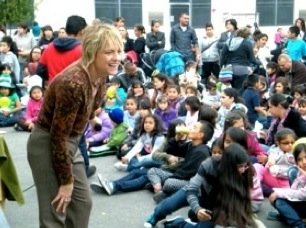 Photo: Craig Jaffurs
Photo: Craig Jaffurs
Book Giveaway: Post a comment below to be entered in a prize draw for a copy of Lee's 101 Ways To Bug Your Friends and Enemies and a buggy doodle from Debbie.
Way back when I started pursuing getting my novels published, Lee Wardlaw offered to read what I had written and give me feedback. It was first time I had received a critique from a professional in the industry, and I was blown away by her generosity, encouragement and advice.
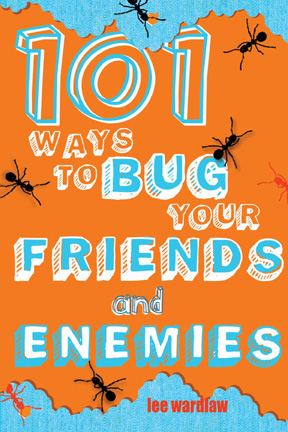 I worked hard on revamping my manuscript and after another round or two, Lee passed my work on to her agent, Ginger Knowlton. Ginger took me on as a client! I'll always be grateful to Lee for that early encouragement and for taking that time with me.
I worked hard on revamping my manuscript and after another round or two, Lee passed my work on to her agent, Ginger Knowlton. Ginger took me on as a client! I'll always be grateful to Lee for that early encouragement and for taking that time with me.
Lee has written over two dozen books for young people and has won many awards and award nominations for her work. Most recently: 2012 Lee Bennett Hopkins Poetry Award (for Won Ton), 2012 NCTE/CLA Notable Children's books in the English Language Arts, 2012 Best Children's Book Award - Los Angeles Book Festival, 2012 ALSC Notable Children's Book , 2012 CCBC Choices as well as nominations for the 2012-13 Chickadee (Maine) Reader's Choice Award, Pennsylvania Young Reader's Choice Award and Rhode Island Reader's Choice Award.
You can find more info about Lee and her work at:
and on Facebook at https://www.facebook.com/leewardlaw
--------
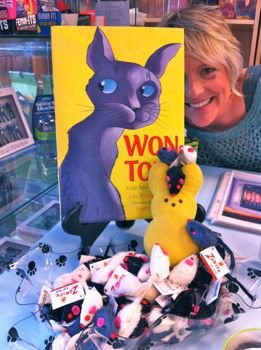 Photo: Lisa Yee
Photo: Lisa Yee
Q. How did you make your first sale?
Plucked from the Slush Pile! Yep, it happens. And I will never, E.V.E.R., forget the day I received that first acceptance. I screamed. I babbled. I called my mom. I might’ve even kissed the mailman…
Q. How did you get your agent?
I met her at the Santa Barbara Writer’s Conference, just a couple of days after I sold that first book. I hadn’t yet written a feigned nonchalant “Why, yes, if you’d like to publish my novel, by all means please feel free to do so” response to the editor, because I was still too busy screaming and babbling. So the agent stepped in and negotiated the contract for me. We worked together for about three years; in that time, she sold two more YA novels and a nonfiction book of mine.
When I decided I wanted to challenge myself by writing picture books, we parted ways. (She specialized in the teen and adult markets.) Over the next few months, I asked every author I met – at school visits, book festivals, SCBWI functions, conferences, etc. – which agents they would recommend. Again and again I heard: “Ginger Knowlton”. She was newish to the agenting world, but she worked at a highly respected New York agency, was learning the ropes from Marilyn Marlow (the Grand Dame of children’s book agents), and had a background in Early Childhood Education. Sold! I queried her with a couple of manuscripts, and she called not long after that, saying she’d like to represent me. I screamed. I babbled. I called my mom. I kissed my husband. (Our new mailman wasn’t nearly as cute.) Ginger and I have worked together now for almost 24 years. She’s stuck by me through thick and thin and anorexic. I adore her.
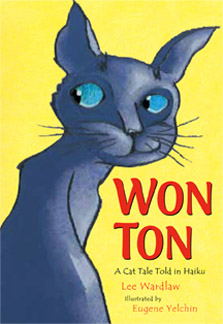 Q. You've written in so many genres in the children's book world. Which feels the most comfortable for you?
Q. You've written in so many genres in the children's book world. Which feels the most comfortable for you?
None. Nada. Zip. Zilch. Zero. If I feel ‘comfortable’ when I’m writing, then I know I’m not challenging myself.
Instead of ‘comfort’, I prefer to experience what psychologist Mihály Csíkszentmihályi calls flow. In his book Creativity: Flow and the Psychology of Discovery and Invention, Dr. C. (didn’t want to attempt that spelling twice!) describes flow as an intense focus on an activity – a concentration so deep that you’re unaware of yourself, your surroundings, of time passing. You see flow most often in Montessori schools. There’s an intense joy on the face of a young child who is wholly immersed in tackling and mastering a task. I experience flow when I’m writing something I love, whether it’s a poem or a picture book, a novel or nonfiction. It happens a lot, too, when I’m creating humorous dialogue for my middle grade characters. Their conversations just, uh, flow…
Q. How much time (or percentage of your time?) do you spend promoting?
In 2011, I had two new books published: a picture book, Won Ton – A Cat Tale Told in Haiku, and the third novel in my middle grade series, 101 Ways to Bug Your Friends and Enemies. It had been almost seven years (!) since I’d last had a new book out, so I really felt invisible. To offset that, I spent the majority of 2011 promoting like crazy.
My year-end totals were: 18 bookstore events, 17 school visits, 7 speaking engagements, 3 Skype visits, 3 blog interviews, 3 TV/radio/print interviews, 3 articles written, and 2 miscellaneous events. Miles driven: 3,500+. WHEW! I did all my own coordinating and publicity for these events, too, so that meant creating/printing/mailing flyers, sending info to schools, contacting newspapers, magazines, events websites, etc., etc. It was a huge job. Won Ton went into a third printing in less than a year, so I have to think the effort was worth it!
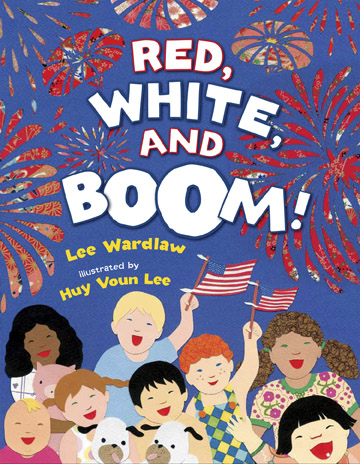 Coming April 22nd, 2012Usually, though, I’d say I spend 50% of my time writing and 50% promoting. The latter is usually through school visits, which I love. Put a microphone in my hand, and I turn into a total ham - - with cloves and brown sugar on top! But the balancing act is a constant struggle. It’s great fun working with and talking to my readers…but sometimes I’d really rather be at home, writing.
Coming April 22nd, 2012Usually, though, I’d say I spend 50% of my time writing and 50% promoting. The latter is usually through school visits, which I love. Put a microphone in my hand, and I turn into a total ham - - with cloves and brown sugar on top! But the balancing act is a constant struggle. It’s great fun working with and talking to my readers…but sometimes I’d really rather be at home, writing.
Q. Do you work on more than one project at a time? If so, how do you manage your time?
Eek. No. If I’m working on a novel, that’s really all I can handle. I tend to juggle a lot of characters and subplots, and I do a lot of research for each book, which means a full-to-overflowing brain. Ditto for my office, which needs shoveling out frequently. Add another novel or picture book to that mix, and I might implode - -or end up on that TV show “Hoarders”.
Sometimes, I can work on a couple of picture books at the same time, but that’s only in the early stages of each, where I’m mainly banging out ideas or plot lines.
Because I have A.D.H.D., I tend to get easily distracted. If I’m distracted, I don’t finish projects. So it’s best if I stick with one project at a time. That being said, I’ve learned that I need to be distracted now and then, otherwise I get bored and don’t finish projects. (Kind of a Catch-22.) So I treat my brain by entertaining it with writing in the mornings and promo stuff in the afternoons. The variety helps.
Q. What are your writing habits? (wordcount goals? rituals? favourite place? etc.)
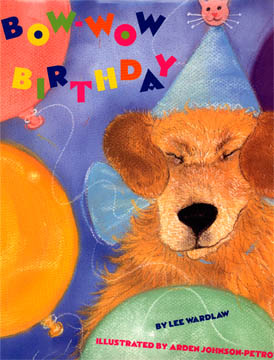 If I’m working on poetry or a picture book, I need to use a pen and notebook, and I need to sit somewhere comfy: curled up on the sofa, outside on the deck, etc. But if I’m writing a novel, I MUST work in my office. I’ve never done well working outdoors or in coffee shops. (Too many distractions.) My office is painted and decorated in shades of green (teal, seafoam, jade, forest), which calms me so I can focus.
If I’m working on poetry or a picture book, I need to use a pen and notebook, and I need to sit somewhere comfy: curled up on the sofa, outside on the deck, etc. But if I’m writing a novel, I MUST work in my office. I’ve never done well working outdoors or in coffee shops. (Too many distractions.) My office is painted and decorated in shades of green (teal, seafoam, jade, forest), which calms me so I can focus.
Other Must-haves:
1. A Mac. Forever and always. And it must have a 27” screen.
2. An Aeron chair (I have neck and lower back issues)
3. An ergonomic keyboard (wrist issues)
4. Natural lighting or a desk lamp with a 100-watt incandescent light bulb (government intervention issues. I’m stockpiling my 100’s! I hate CFLs. They make me squint.)
5. Plenty of protein snacks. (hypoglycemia issues)
6. A glass of iced tea with extra lemon, mint leaves and Splenda.
7. A cat or two curled up on my printer or on the floor heat vent.
I start work early-ish: 8:00 a.m. (I prefer between 5 and 6 a.m., but with a husband and teenaged son at home, those times aren’t optimal.) I write until noon; take an hour break; then go back to work until 2:40 when I leave to pick up my son at the high school.
My habits have changed over the years. In the past, my minimum goal was three hours or three pages, whichever came first. Now, if I’m working on a novel, I’ll set a different goal for myself every day, depending on where I am in the story. If I think I can rough out two or three major scenes in a particular chapter, then that’s my goal. If I know it’s going to be a particularly difficult chapter, for whatever reason, then I may set a goal of writing only one scene.
It’s that variety that keeps me from getting distracted!
When working on 101 Ways to Bug Your Friends and Enemies, I was really having a hard time focusing. (For some people, like me, ADHD gets worse asyou get older.) So instead of writing the book sequentially, I allowed myself to hop around, writing chapters out of order. That was great fun, and it kept me motivated.
Q. How much prep do you do before you start writing?
Tons.
Whether it’s a picture book or a novel, I write pages and pages about all the central characters, asking myself questions about who they are, what they want, why they want it, how they’re prevented from getting it, etc. It’s crucial to know what motivates your characters – what values move them to action – and why. Otherwise, you won’t know how they’ll act or react in every situation you put them in.
Each book also involves research. Take, for example, WON TON – A CATTALE TOLD IN HAIKU, the story of a wary shelter cat and the boy who adopts him. Now I know cats. My first spoken word was ‘kitty’ and I’ve shared my life with probably 30 cats over the years. BUT, I still needed to research cat behavior, specifically that of adult cats who’ve spent most of their lives in an animal shelter. I researched shelters, too, and how best to introduce a cat to a new home. (I thought it important for the book to be accurate so shelters would get behind it, maybe even carry it in their gift shops.) I also researched haiku - - American haiku is different from Japanese haiku - - and that’s when I realized I’d actually written the book in senryu! That was an important distinction for me to be awareof if I wanted elementary schools to use the book as a teaching supplement.
After the character work and the research, then I do a rough outline of the book. I ALWAYS know how the story is going to end before I start writing. For me, writing a novel is like taking a trip. You don’t just get in the car and start driving willy-nilly. (Well, in real life you might, if you’re the adventurous sort, but if you do that in fiction, you’ll end up with stream of consciousness stuff, not a novel.)
Before you back out of the garage, you need a destination and you need a road map. The road map is the plot outline. My outlines tend to change along the way, taking little detours here and there, picking up extra passengers (characters), maybe getting a flat tire (more conflict!), but I make sure the basic road map stays the same. That way, I and my story get to The End in one piece.
Q. What's the biggest mistake that new writers tend to make?
Ha. I don’t know. There are so many from which to choose! Not having read a children’s book since before the invention of dirt…not having been around children since being children themselves…worrying too much about contracts and agents and merchandising instead of focusing on their craft…submitting stories that aren’t stories at all, but incidents or anecdotes…the list goes on.
My biggest mistake, way back when, was writing picture books that featured inanimate, anthropomorphic characters. Kind of like The Missing Piece by Shel Silverstein – but without his wit, intelligence, heart and drawing talents! My early picture books were awful. Of course, I didn’t know that then…
Q. What advice do you have for aspiring picture book writers?
1. Read, read, read, read, read picture books. Pick out your favorites and take them apart, analyzing what you like about them and why; what about them resonates within you; what’s their unique tone, their style; what makes their characters fresh; what is special about their voice; and what gives them enough appeal to be read and re-read up to 500 times;
2. Take a poetry-writing class. Learning how to distill a story’s essence; using rhythmic, evocative language and vivid imagery; creating something that cries to be read aloud - - all of that is what you need to write poetry and picture books. I don’t think it’s an accident that WON TON is my most successful picture book. I started writing it while taking a poetry class from children’s book author and poet Ellen Kelley.
Q. For your picture books, how much interaction did you have (if any) with the illustrator?
None. Well, I might send them an email, introducing myself and saying I’m looking forward to the publication of ‘our’ book. But that’s it. Typically, the author and illustrator don’t collaborate on a picture book project. The author writes the story, the editor picks the illustrator, then the illustrator draws the pictures.
People are always surprised by this. But it makes sense. I wouldn’t want an illustrator standing over me, saying: “Gosh, I don’t know how to draw cats. Could you make your story about dogs, instead?” And I’m sure an illustrator wouldn’t want me dictating to him/her what kind of style, medium, etc., should be used. Of course, this means you have to have an extremely savvy editor, one with a clear vision of what kind of art will best complement and enhance the story.
Q. What are three things you wish you had known when you first started your writing career?
1. That rejections aren’t personal
2. That an editor’s suggestions aren’t set in stone
3. How much publicity and promotion I’d have to do!
Q. Any news about current or upcoming projects you'd like to share?
RED, WHITE & BOOM! (Holt, ages 2-6, illustrated by Huy Voun Lee) will debut in April. It’s a rhyming picture book about the ways families from different cultures celebrate our country’s independence.
I’m finishing up a sequel to WON TON…and making notes for 101 WAYS TO BUG YOUR BROTHER AND SISTER…and I have a cool idea for a nonfiction project (but I’m not saying what it is!).
-----
Also see other Inkygirl Interviews.
As some of you already know, I was thrilled to be picked for the SCBWI Illustration Mentorship Program at last year's Summer Conference in LA. Thrilled as in "can this really be happening to me" thrilled, especially when combined with the offer from Simon & Schuster Books For Young Readers to illustrate Michael Ian Black's new picture book, I'm Bored.
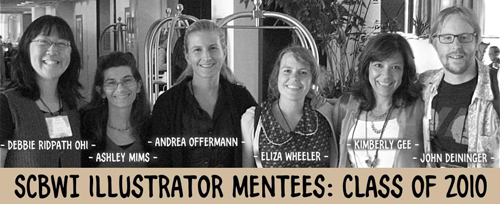
The six of us got together during the conference, just to chat and get to know each other a little better: Eliza Wheeler, Andrea Offermann, John Deininger, Kimberly Gee, Ashley Mims and me. We discovered (to our mutual relief, I suspect) that we all got along very well, and we decided to launch our own website at KidLitArtists.com.
We also kept in touch via group email about what we were all up to, shared successes and disappointments, critique and encouragement. We hung out when we attended the same SCBWI events.
At the SCBWI Summer Conference this year, some of us were joking with Caldecott-winning children's book illustrator & SCBWI Illustration Mentor David Diaz, saying we'd love to snoop through his studio (I believe it was Eliza who was nervy enough to suggest it). David surprised us by saying it was a great idea. In fact, he sent out an invite soon after the conference, and said he wanted to invite some other mentees as well.
And so LOST WEEKEND was born!
Sadly, not all the 2010 and 2011 Mentees could make it to Lost Weekend (we missed you guys!). Here's the attendee list:
Mentees: Class of 2010:
Andrea Offermann, Eliza Wheeler and me
Mentees: Class of 2011:
Christina Forshay, Jessica Lanan, Juana Martinez-Neal, Andrea Zuill
Others invited by David:
Bonnie Adamson and Alice Ratterree
Note: This wasn't an officially sanctioned SCBWI event but rather an act of generosity by David. I admire his courage, inviting a bunch of strangers into his private home. I think he was a tad nervous at first, wondering what he had got himself into.
(Above: piece by David Diaz)
Some of us stayed at the hotel, some at David's. I loved David's house with its high ceilings, full of light and color. There was art everywhere, including many gorgeous and interesting pieces by David and his son Ariel.
(Above: Piece by Ariel Diaz)
David did most of the cooking…and he's really good at it! My mouth is watering even as I type this, remembering these home-baked popovers fresh out of the oven, light as air and slathered with fresh cream, jam or savoured plain:
Here are just some of the other things we feasted on during the weekend:
German pancakes, scrambled eggs with sautéed spinach, smoked bacon, sausage.
"Sin-cleansing" French pressed coffee.
Handmade pasta, with an Putanesca Sauce with Hot Italian sausage
Salad with goat cheese, candied walnuts, crasins, and white balsamic vinegar dressing
Sformata di Ricotta
Oven roasted garlic
Fresh bread
Jambalaya rice with sausage, mushrooms, grilled tri-tip
Pumpkin pie
Chocolate chip coconut brownies
Apple raspberry crumb pie and ice cream.
I'm pretty sure I left Lost Weekend heavier than when I arrived.
Plus Bonnie introduced me to Pickled Okra (yummmmmmmmmmmm):
which go wonderfully in these:
I loved the buzz of activity in the kitchen as we chopped and stirred under David's tutelage, conversation and laughter (a LOT of laughter) filling the house.
Even food shopping was fun:
I discovered Von's, which is apparently a chain grocery story in California. "V-a-u-g-h-n-s," said David, when I asked him how to spell it. I believed him and started writing it down until I heard the others sniggering. Kidlit illustrators can be so MEEEEEAN. :-D
We spent a lot of time just chatting in front of the fireplace. We each gave a brief demo of how we worked, talking about our process. It was funny, really -- each one of us basically felt like our own process was SO boring yet when it came to seeing how the others did their work, we were each fascinated. Lots of kidlit and art talk and picture book writing talk, plus browsing of each other's portfolios.
On Sunday, the weather cleared up so we decided to go walking on the beach. SUCH a nice change from Toronto weather!
We left our shoes in a pile on the beach:
David reassured us that no one would steal them. :-)
And holy cow, I know it sounds like a cliché, but it felt SO GREAT to walk barefoot along the beach!
and we saw pelicans:
and hang gliders:
David took us to the Self-Realization Fellowship Meditation Garden, with its beautiful gardens and koi ponds:
We got in trouble from a security guard in the gardens when we laughed too much as we tried to get this photo taken:
Darned noisy kidlit illustrators!
Above: David let us snoop through some of his archives from earlier in his career
It was fascinating to see some of David's earlier work, and hear his explanations of how and why he changed his illustration style. We also got to see sketches and drawings from Mother Earth Watches (working title, will change), his upcoming book with Chronicle Books (tentative publication date: Spring 2013).
David taught us a new technique: taping down a framed area on masonite, painting a background texture/color using acrylics, then a layer of matte medium (or at least I had to do this since my base layer of acrylic was already so textured), then drawing in conte, then spraying with a fixative.
Some of us (hand waving here) didn't normally work with acrylics, so were a bit nervous about the process. BUT it ended up being a lot of fun as well as enlightening -- it was good to push beyond our normal creative comfort zones, especially in a safe and encouraging environment like the one at Lost Weekend.
Also very cool to see the different approaches everyone took in their projects.
Andrea Zuill, who drove to David's, brought some of her paintings later in the weekend for us to look at. I LOVE her work! She also brought a print for each of us as a gift. Here's the one she gave me:
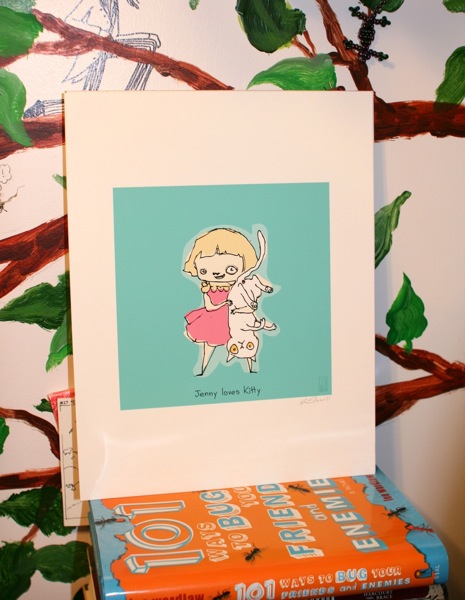
You can see more of Andrea's work at http://www.andreazuill.com/
Continued in Part 2: Lost Weekend With David Diaz.
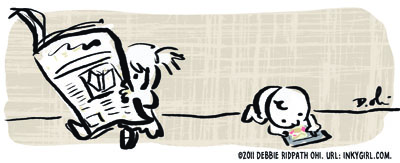
Making Sense of Digital Books for Kids Part 1 - Part 2 - Wired
Pop Star Taylor Swift Donates 6,000 Kids Books to PA Reading Public Library - School Library Journal
'Shine' Withdrawn as NBA Young People’s Literature Nominee - Publishers Weekly
Are you an author thinking of writing or writing and illustrating a picture book? If so, check out the Kidlitart Picture Book Dummy Challenge, 25-week online group challenge to create a submit a picture book dummy. It starts today and ends on June 30th.
Excerpt from the description of who can join:
Though geared primarily toward author/illustrators, writers who are not artists can benefit from portions of the dummy exercise, and illustrators without an original manuscript can use the process to create a dummy portfolio piece.
Find out more at: http://kidlitart.blogspot.com/2011/01/its-here.html
Here's the blog post schedule:
Jan. 6-Jan. 13 (1 week): Pick your project
Jan. 13-Feb. 10 (4 weeks): Draft the story
Feb. 10-Feb. 24 (2 weeks): Develop the characters
Feb. 24-Mar. 10 (2 weeks): Storyboard text and art
Mar. 10-May 5 (8 weeks): Produce tight, full-size sketches
May 5-Jun. 2 (4 weeks): Produce final art of two spreads
Jun. 2-Jun. 16 (2 weeks): Comp the cover and assemble the dummy
Jun. 16-Jun. 23 (1 week): Research submissions; prepare dummy package
Jun. 23-Jun. 30 (1 week): Submit
Jun. 30: Wrap party!
I'm pleased to announce that the SCBWI Illustration Mentees Blog is now ready for visitors! In it, you'll find info and resources for those interested in children's book illustration as well as updates about our own illustration projects. I'll also be posting from the viewpoint of a writer venturing into children's book illustration for the first time.
Please do come visit, and tell your friends. :-)
 Thursday, September 2, 2010 at 10:26 AM |
Thursday, September 2, 2010 at 10:26 AM |  Post a Comment |
Post a Comment |  Email Article |
Email Article |  Share Article |
Share Article |  Permalink
Permalink